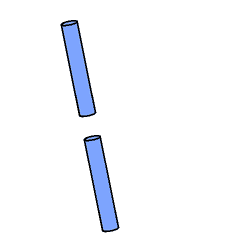Infant Object Perception











Instructions
Examine the movie playing at left. When you’re ready to move on, click here.
Instructions
Now look at the movie again. When you’re ready to move on, click here.
Instructions
Now look at the movie again. When you’re ready to move on, click here.
Note: This is not a bug in the website!
Instructions
Now take a look at this movie. When you’re ready to move on, click here.
What’s Going On?
You just participated in an adult version of an experiment usually done with human infants as participants. The experimental procedure is called habituation, and it relies on the universal human instinct to become bored with anything you encounter over and over again. You probably interpreted the first movie as a single blue stick moving back and forth behind a purple block. The first time they are asked to examine the movie, most people look at it for a decent amount of time. As the experiment progresses, however, their looking times tend to go down.
After seeing the same movie three times, you saw a different movie, which you probably interpreted as two separate but perfectly aligned sticks moving back and forth (with no occluding block). Most people look longer at this movie than they did at the previous one, because they find it interesting that something has changed. An increase in looking time is a strong indication that observers can see the difference between the two movies.
Of course, it would have been much more efficient to simply ask you whether or not you saw the difference between the two movies. But what if we wanted to test a 4-month-old infant? Obviously, we cannot question such a participant directly. To get around infants’ lack of verbal abilities, researchers have used the procedure you just experienced.
Habituation Procedure
In the experiment demonstrated here, the infant participant was seated in his or her mother’s lap, facing something like a puppet stage. Once the infant was in a calm state, a blind was opened to reveal a stick moving behind an occluding block (like the movie at top left, although in the actual experiment the infant saw real 3-D objects). An experimenter sat behind the stage, looking through a peephole. When the experimenter saw the infant first look at the stick/block, he or she started a stopwatch, stopping the watch when the infant looked away from the action. At that point, the blind was closed and the infant was given a short rest. Next, the blind was opened again and the experimenter recorded how long the infant looked at the display during the second exposure.
This sequence of events was repeated until the infant was so bored that he or she barely glanced at the display. Then, the blind opened to reveal one of the two displays shown in at bottom left. The experimental question was which of these two displays the infant would find more interesting. If the infant, like adults, saw the initial movie as a single stick moving behind the occluder, than he or she should have found the display on the left more interesting, because the single stick had been transformed into two separate sticks. In fact, this is just what the researchers found: infants had a strong tendency to dishabituate (look longer) at the left-hand display, whereas when they showed infants the right-hand display, they looked about as long at it as they had to the initial display with the occluding block.
This result is interesting because the visual input in the first display contains no explicit signal that the top and bottom halves of the stick are actually connected. To perceive them as connected, the 4-month-olds must have already been using sophisticated strategies (such as the good continuation and common fate grouping principles) to organize the visual input into objects.